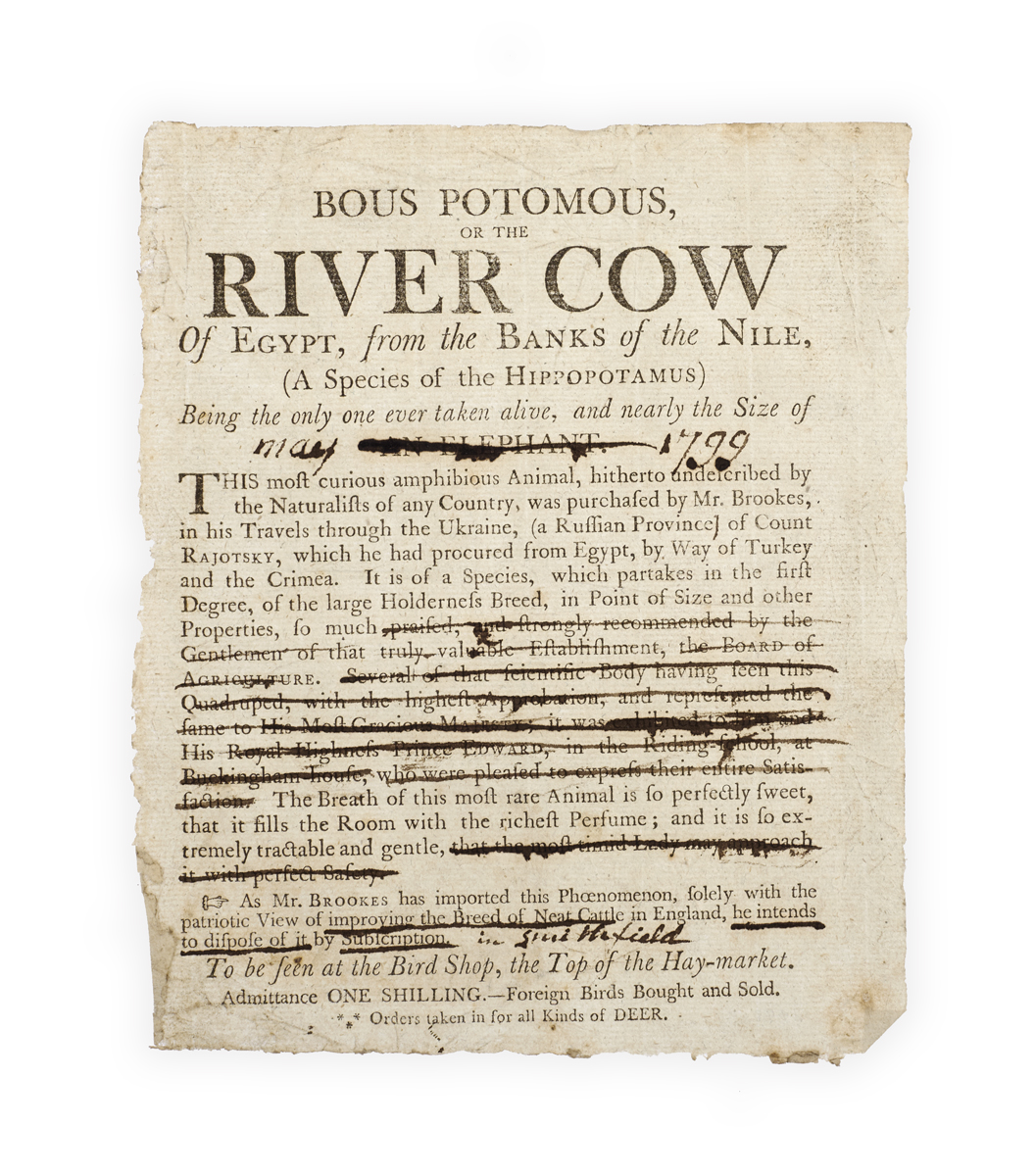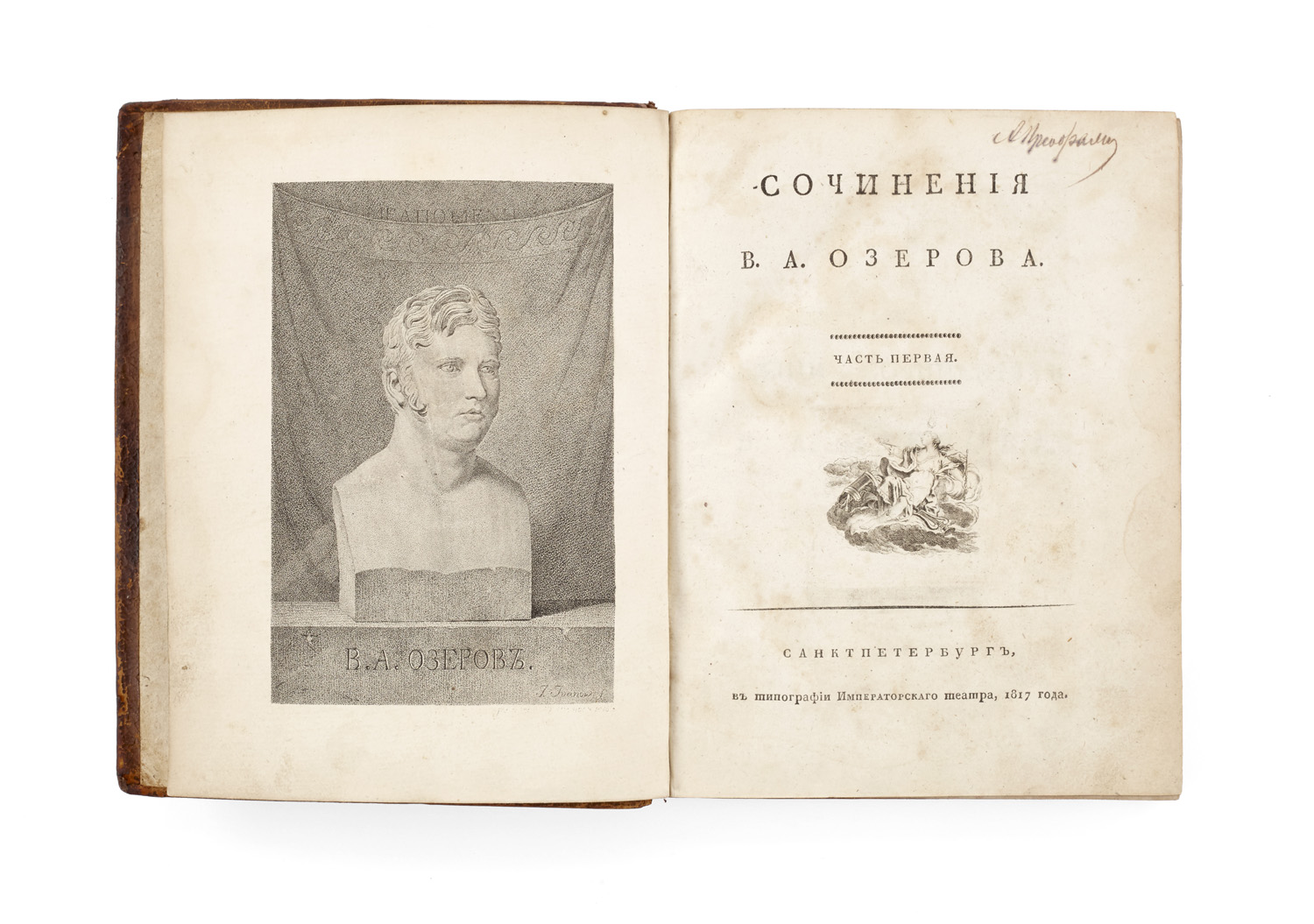
A HIPPO IN THE HAYMARKET?
[BROOKES, Joshua, Paul, or John?.]
Bous Potamous, or the River Cow of Egypt, from the Banks of the Nile, (A Species of the Hippopotamus) being the only one ever taken alive and nearly the Size of an Elephant …
[London, dated in manuscript May 1799.]
4to handbill, printed on one side, numerous lines crossed through in pen, and the location for the sale ‘in Smithfield’ added.

Added to your basket:
Bous Potamous, or the River Cow of Egypt, from the Banks of the Nile, (A Species of the Hippopotamus) being the only one ever taken alive and nearly the Size of an Elephant …
Unique broadside advertising the exhibition, and subsequent sale, of a live hippopotamus – possibly the earliest record of a live hippo in England – they were notoriously difficult to transport and keep alive and the arrival of a baby at London Zoo in 1849 was touted as the first in Europe since the Roman period. It was seemingly not: Benjamin Silliman (of Yale) reported seeing one in 1805, and Byron likewise in 1813. The present handbill suggests that the hippo, ‘a curious amphibious animal, hitherto undescribed by the Naturalist of any Country’, was shown to George III at Buckingham House, but we can find no record of this event, and given that portion is crossed through here, perhaps it was a claim too far. Indeed there is little collaborating evidence for the exhibition, suggesting that the animal might have died before it could be shown.
Joshua Brookes (will proved 1803) was probably the most prominent dealer in exotic animals in London in the second half of the eighteenth century. Though modest sounding, his ‘Bird Shop, the Top of the Hay-market’ was a substantial location, two houses together, ideally placed to capitalise on the new West End’s wealthy clientele. It was in fact his third business; his original menagerie, at Gray’s Inn Gate, Holborn, advertised in 1763 the sale of birds from India and America. By the late 1760s he was selling species as diverse as antelope, lions, monkeys and porcupines; he sold plants and seeds provided him by William Young, the royal botanist; and his son Paul travelled to Africa, Asia, South America and Russia to buy stock – the hippo apparently came from a certain Count Rajotsky in the Ukraine, who had it from ‘Egypt by way of Turkey and the Crimea’. The Haymarket site, opened in 1777, was first operated by Mary Cross, wife of a former partner, and then by his son John. It was a success, placing him at the top end of the market: in the 1780s for example he sold the animals belonging of the Duchess of Portland, a decade or so later he provided 16 reindeer to the Duke of Norfolk and transported emus on behalf of Joseph Banks. Here he notes ‘Foreign Birds bought and Sold. Orders taken in for all kinds of Deer’.
This is likely a proof or retained copy, altered in manuscript to provide copy for a later untraced advertisement. An earlier version with textual differences (‘Just arrived, a live boos potamous’) is known in one copy, among Daniel Lysons’s Collectanea at the British Library. The present version, with a different heading, also adds a line at the foot: ‘As Mr. Brookes has imported this Phœnomenon, solely with the patriotic View of improving the Breed of Neat Cattle in England, he intends to dispose of it by Subscription [in Smithfield].’ One can only imagine the expression on the faces of the poor livestock faced with this prospect. Whether the sale ‘by Subscription’ at Smithfield went ahead we cannot determine. Could it all be, as Caroline Grigson suggests, an elaborate hoax at the Brookes’ expense? Or perhaps the animal was a fake – within the decade John Brookes was in court for applying spots to a camel to confect a ‘cameleopard’.
See Christopher Plumb, ‘Exotic animals in eighteenth-century Britain’ (University of Manchester PhD thesis, 2010) and Caroline Grigson, The History of Exotic Animals in England, 1100–1837, 2016.

